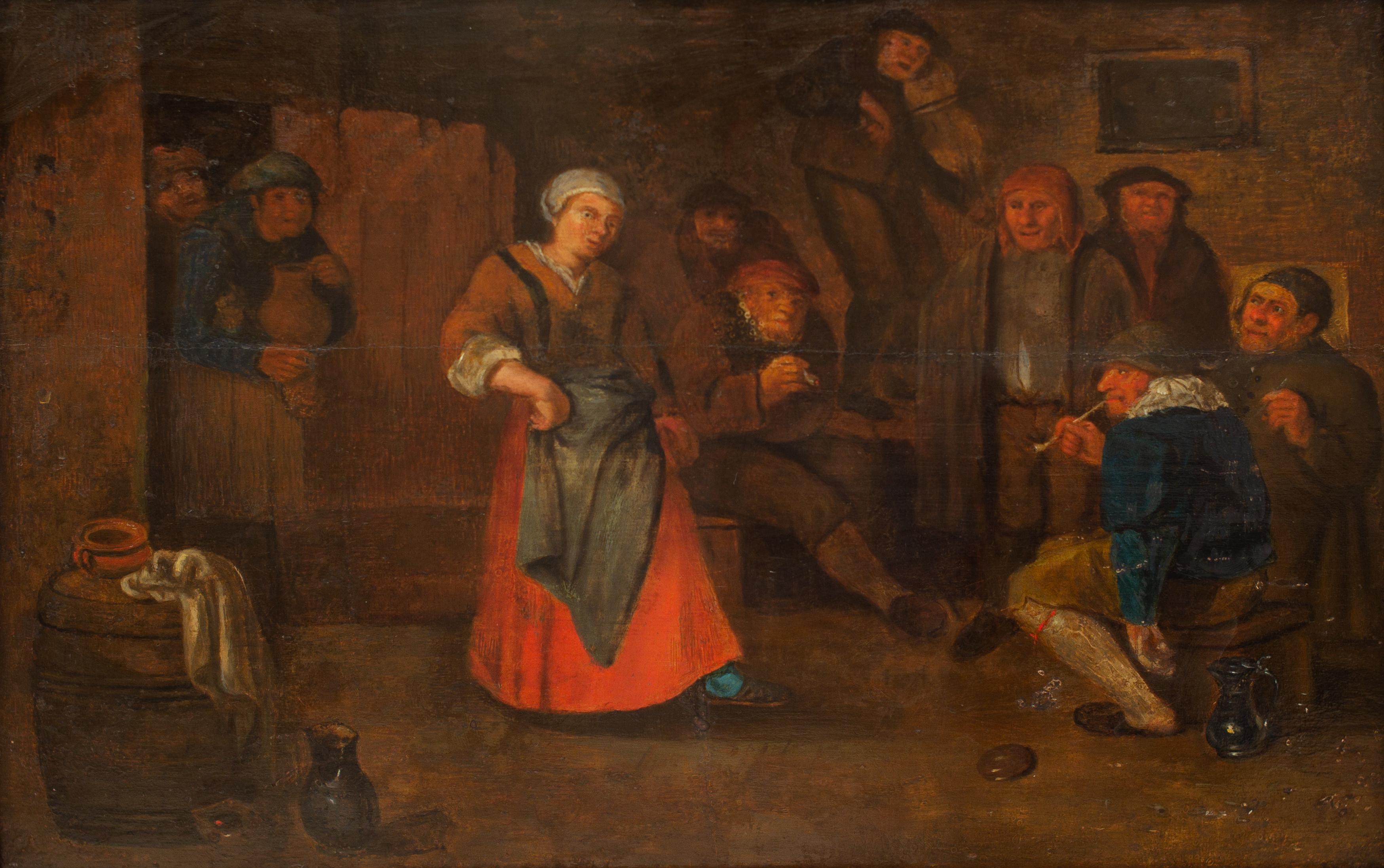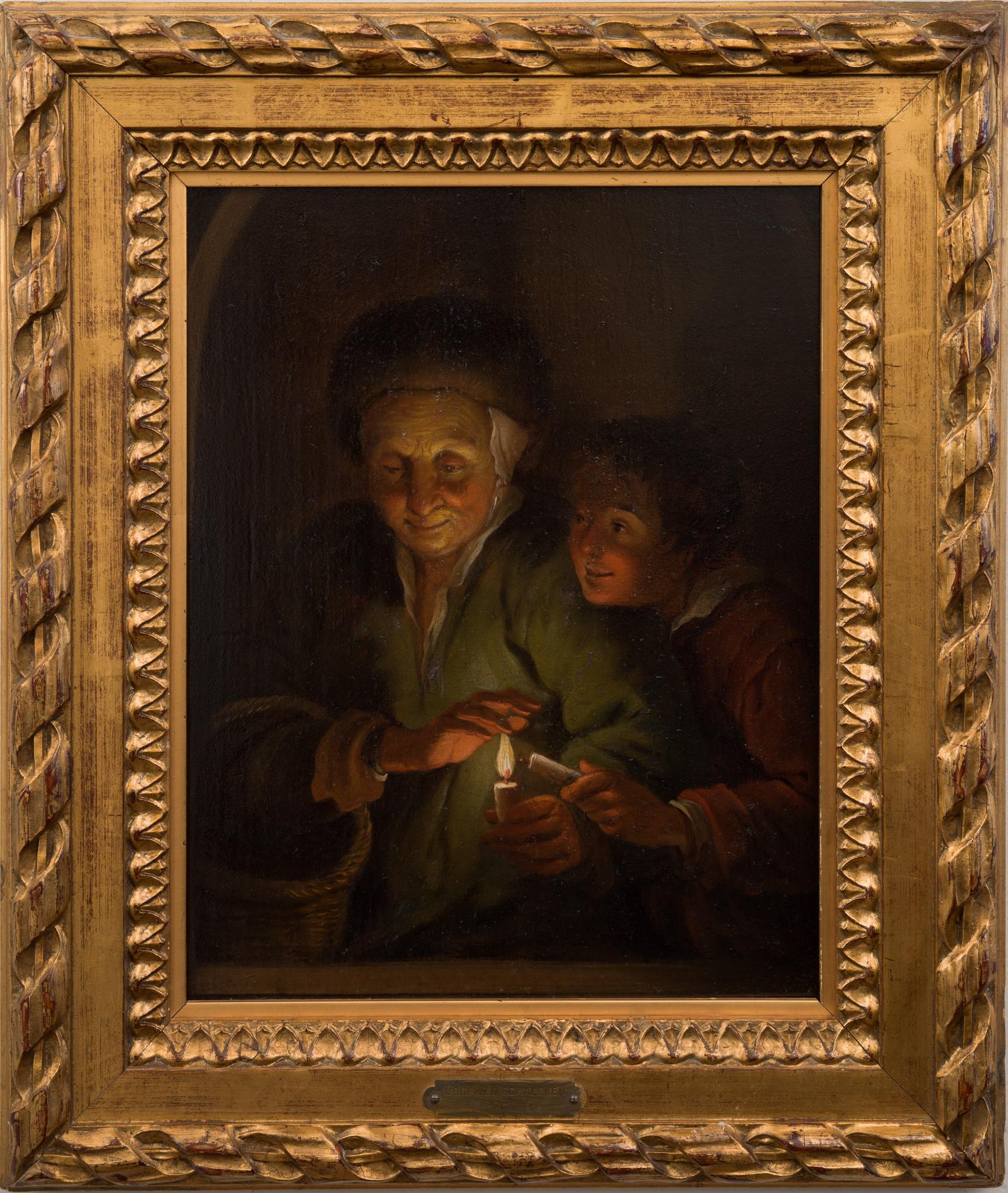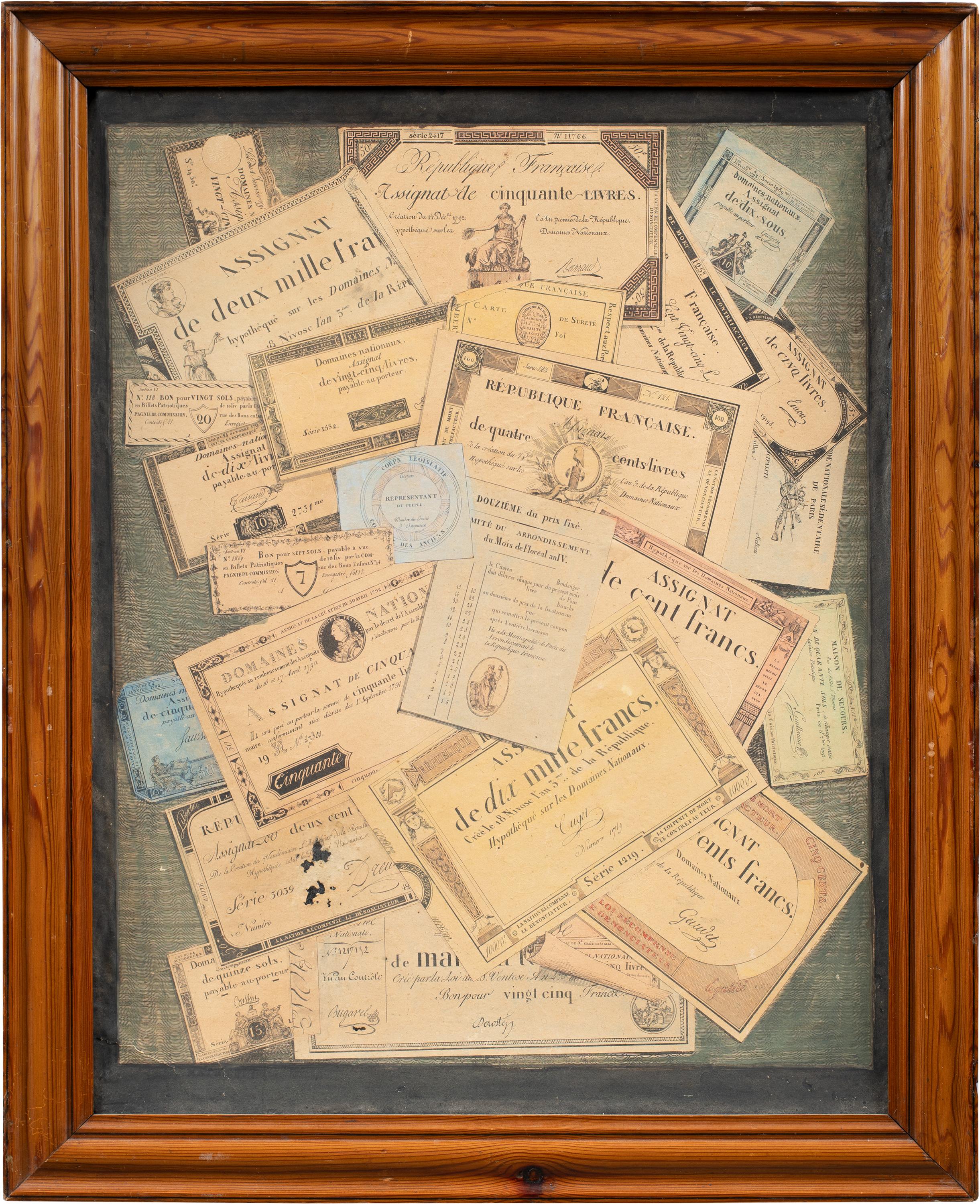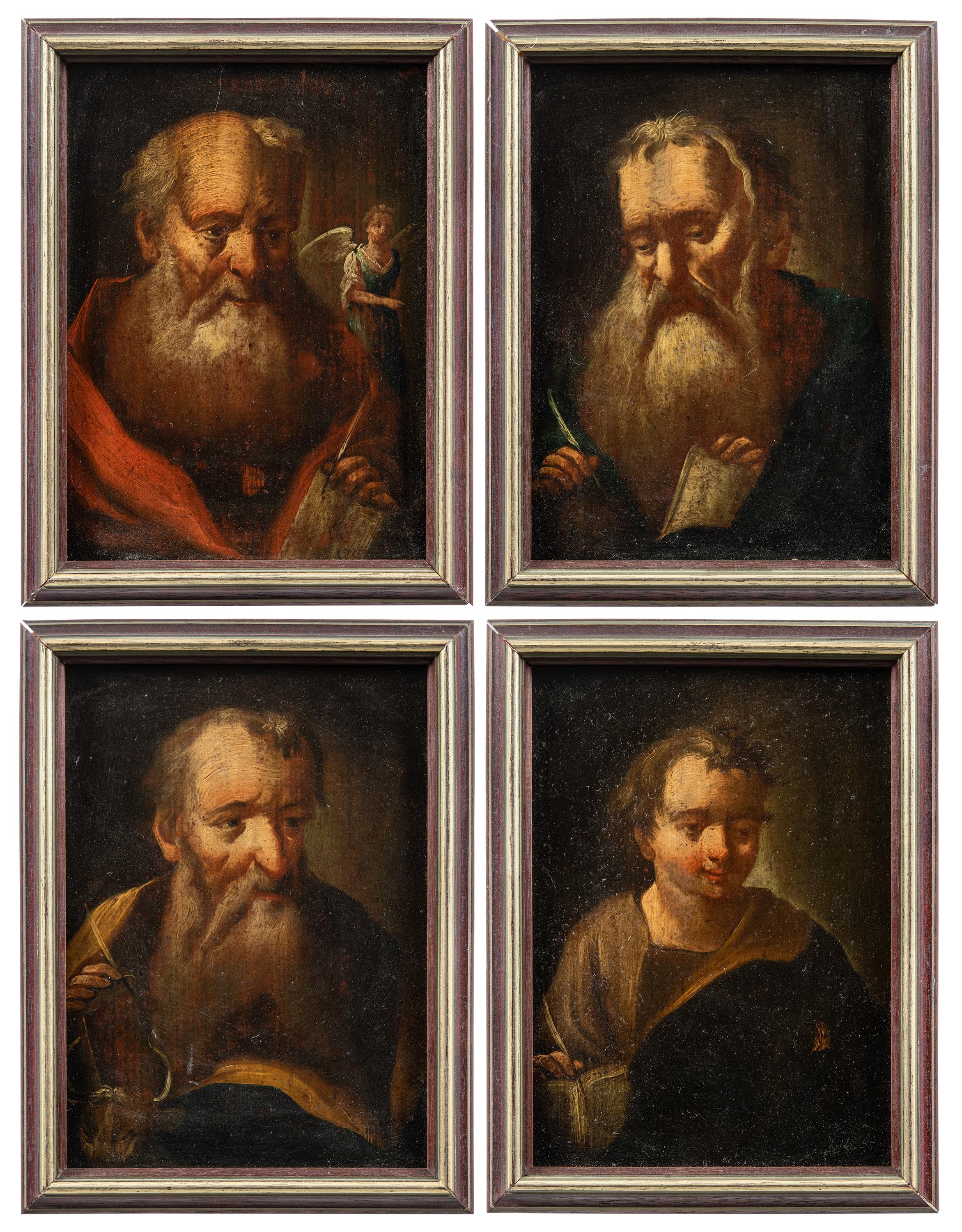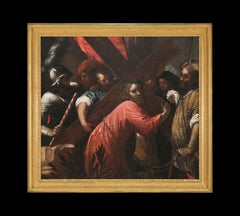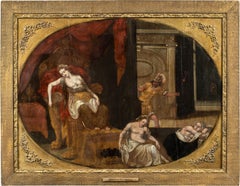Items Similar to San Francesco, Santa Caterina d’Alessandria, Sant’Agostino e San Nicola
Want more images or videos?
Request additional images or videos from the seller
1 of 3
Luca SignorelliSan Francesco, Santa Caterina d’Alessandria, Sant’Agostino e San Nicola1500
1500
About the Item
Luca Signorelli (Cortona 1445 - 1523). € 40,000
San Francesco, Santa Caterina d’Alessandria, Sant'Agostino and San Nicola da Tolentino
Oil on panel, 13.5x52.5x1 cm; with 18x55 frame
Provenance: Provenance: with Paolo Paolini, Rome, circa 1924. with Giuseppe Bellesi, London, active circa 1924-1948. Dr. Raimond van Marle, Perugia.
The four tablets are now mounted in a single frame as if they were a predella. In reality
looking at the wood on the back you can see how this is not continuous and that all the figures are
painted in separate plates. There is no doubt that they come from the same complex, but originally
they were mounted in a different way and you will see later.
They represent four standing saints, painted against a landscape background, all of them are
recognizable by their usual attributes, Francesco dressed in a brown habit and with the stigmata well
in evidence, Catherine of Alexandria has the toothed wheel, symbol of martyrdom, Augustine wears
the usual black robe under the cope and is intent on reading a book, since he is the father of the church
and, finally, St. Nicholas is also dressed in black and carries with him, the lily, the book and has a sun
golden on the heart, all details that make it recognizable without a doubt.
The four characters are divided by columns that perfectly match each other
This does not mean that they were mounted this way, but that they come from the same
Opera. There are no signs of cuts on the top or bottom edge and we can
think this is the original size.
The painting is almost perfectly preserved, it is only just cleaned in the sky which reveals a
some of the underlying preparation, but the blue pigment is usually the least resistant e
it can often occur in minor damage like this. The small figures, on the other hand, are read on
punctually with all the shadows of the garments that reveal a sharp and sure design, a light
light that lights up on the outer folds, with the shadows on the contrary very deep in the areas
of the garments that are in the dark. The crests of the drapery are broken and shiny, as can be seen
very well in Santa Caterina and the landscape slopes gently towards the bottom. The small ones
dimensions certainly do not allow a higher finish than the one proposed, also because
it is a marginal part of the altarpiece. A predella, perhaps, or part of a
piliero of the frame.
However, they are images that live their space with a certain monumentality and with one
construction of volumes that gives a sense of quality. Some details are less polished, such as the
fingers, painted quickly, as pointed, and even the faces are a bit stereotyped
as if the painter repeated the same model and the same drawing.
However, it is a work of Luca Signorelli's full maturity. All the details that you are
described above, and also the general construction of the figures, are truly identifying characters
of the painter's style (for an overview of the mature style A. Delpriori, The artistic maturity:
1490-1515, in Luca Signorelli, cat. of the exhibition (Perugia 2012), curated by F. De Chirico, V.
Garibaldi, T. Henry, F. F. Mancini, Cinisello Balsamo 2012, pp. 73-85 and T. Henry, The Life and
Style of Luca Signorelli, New Haven and London 2012, pp. 263-290). The hunched position
of the absorted Agostino is congruent to practically all the analogous figures painted by Signorelli
from the beginning of the second decade of the sixteenth century, until the end of his life, which took place in 1523.
Luca Signorelli is the same age as Perugino and shares many moments of his career with him
it was even thought that they were together in Piero della Francesca's workshop, where he is
both Luca and a certain Pietro de Castroplebis are documented, who today is probably thought to be
Pietro di Galeotto, because Vannucci had to have an education in the Florentine atelier of
Verrocchio. However, they are virtuous short circuits in the history of Art because in fact, starting from
eighties with his intervention on the walls of the Sistine, Signorelli meets Verrocchismo
more observant and will somehow remain fascinated by it, mixing that turgid style with
the adamantine light brought to the same sites by Bartolomeo della Gatta. In 1483 Signorelli
he was a well-known artist and at the height of fame, so much so that he painted for Girolamo Basso della
Rovere in Loreto, for Lorenzo dei Medici in Florence and then in Volterra and then for the Bichi in Siena. In the
nineties he took refuge in Città di Castello, favorite painter of the Vitelli. He then worked in Monteoliveto,
again in Siena, obviously in Orvieto where he left one of the most influential works of all
Renaissance, the frescoes of the Chapel of San Brizio, copied by the same Michelangelo and
Raphael (for the whole life of the painter see T. Henry, The Life and Art of Luca Signorelli, New
Haven and London 2012).
In the first decade of the sixteenth century he was able to counteract with a monumental gigantism, but
never exaggerated, to the new temptations in a beautiful way that the two artists mentioned above
they were synthesizing between Rome and Florence. In the second decade he is stable in Cortona, but
he continues to work throughout the upper Tiber valley and builds a flourishing shop that will be
long-lived, as he explained well in his doctoral thesis at the University of Florence Daniele
Simonelli (whose results are published in part in D. Simonelli, Raphaelesque Exercises in Cortona,
a predella by Papacello, in "Nuovi Studi", 23, 2018, pp. 109-113).
These are the years in which the painter becomes more schematic and repetitive, probably assisted
by the students, but he is always able to surprise as for the Communion of the Apostles of
Cortona Diocesan Museum, from 1513, which is truly a masterpiece of a mature and still artist
loud.
The saints who present themselves here are perfectly inserted in this phase and are confronted with the
Pala degli Uffizi from Sant'Agostino in Cortona, with the Deposition of Umbertide, with the
Madonna and Saints from the National Gallery of London which comes from Montone and with all the paintings by
these years, let's say between 1510 and 1515.
Assuming they are parts of a predella, the dimensions also justify the same
dating. In fact, as time passes, Signorelli uses thinner altar steps. To
example, the predella of the Pala Bichi for Sant'Agostino in Siena of 1489 is 25 cm high
stupendous (where the painter reacts to young Raphael and perhaps to Girolamo Genga) under the
Compianto di Cortona, dated 1501-02, is 29 cm; that of Altemburg which was originally under the
Altarpiece of Arcevia from 1508, now in Brera, is 33 cm high (for the reconstruction of this A
Delpriori, Girolamo Genga and Luca Signorelli, hypotheses for a new path, in Girolamo Genga:
an oblique way in a modern way, conference proceedings (Bologna 2016), edited by B. Agosti, A.
M. Ambrosini Massari, M. Beltramini, S. Ginzburg, Lavis 2018, pp. 77-89, in part. pp. 78-79.
That of Umbertide, still in the church of Santa Croce, more or less from 1515 is 17.5 cm; that
of the Pinacoteca di Brera in Milan, but painted for the altarpiece of Santa Cristina in London (evoked
above) from about 1514 is 18 cm; the one set up on the frame for the Augustinian altarpiece of the
Uffizi is 18.5 cm, practically all the same or almost the height of our small tables. And
the list could also go on with erratic fragments such as the Adoration of the Shepherds
of the National Gallery in London and more (for the whole catalog see T. Henry, L
Kanter, G. Testa, Luca Signorelli, Milan 2002).
The presence of two Augustinian saints, the same bishop of Hippo and then of St. Nicholas of Tolentino,
could suggest an Augustinian context, but they are saints whose cult was very widespread a
Cortona and the fact that there is also St. Francis suggests not to look for the provenance from
he asked about a particular order.
There are many predella fragments from Luca Signorelli's catalog that have yet to be found
their location and research, therefore, becomes interesting. In summary, our four saints
they are 18cm tall and equally wide, they are all lit from the left and come from
same context. The wood has a horizontal grain even if it is not continuous. The columns
moldings that separate the images have been a bit helped by the restoration to make them,
rightly, more pleasant and homogeneous to the eye, but we know that underneath you can see the
preparation and which originally were probably not painted, but which were the housing
for wooden columns of the frame. The height dimensions are the original ones, since i
margins somewhere retain a hint of the color beard.
Luca Signorelli uses the molded columns many times to divide the scenes of his predella
which often have irregular spaces, with wider compartments and others much narrower than
they follow the needs of the narrative more than the symmetry of the composition. So it is, for
for example, for the predella of Bucharest, in the State Museum, that of the Uffizi, and also the panels beyond
below the Deposition of Umbertide, just to give a few examples.
The same style point of our four saints, with the well-built figures, the scratched design,
their small monumentality and somewhat mannered faces, is found in a series of tablets that
they seem to be perfectly related to our hips for size. It is two
fragments of predella of the Detroit Institute of Art and two others passed by Sotheby's in Florence in the
eighties of the last century. All four are 18cm tall (Detroit's few
millimeters more), all four are illuminated from the left and can be seen in all the fragments, on the sides
the imprint of a molded column dividing the scenes, of which more than anything else the imprint remains
on the preparation, exactly as in the tablets with the saints before the last restoration.
Laurence Kanter, who rebuilt that series, had speculated that it was next to them
also a genuflected Saint Sebastian in a private collection which, however, has different dimensions,
especially in height and that I would keep out of this context (T. Henry, L. Kanter, G. Testa, Luca
Signorelli, Milan 2002, catt. 109-113, pp. 231-233 and also T. Henry, The Life and Style of Luca
Signorelli, New Haven and London 2012, pp. 275-277) The same scholar also thought that the
predella divided between the market and the Detroit Museum was the predella of the altarpiece with the Disbelief
of St. Thomas and donor of which we know only the photo because it was destroyed in a fire in
1995, but which originally came from the parish church of San Vincenzo in Cortona. This was 143 wide
cm, but the figure of the client in the abyss on the right (this Serafino Mazzola, canon of
Cortona Cathedral) is certainly cut by several, at least 20, since we should be able to
rebuild at least the entire left shoulder and the same must be done for the other side. The
Detroit daisies are 42.5 cm wide each and those passed up for auction in Florence
respectively 19 and 27 cm. In total, therefore, these tables develop 111 cm. Ours are
18 cm wide each for a total of 183 cm. Considering the cuts of the main blade the
dimensions are almost punctual and one might even think that the angels with the coats of arms
preserved at the Etruscan Academy in Cortona, which bear the dedication by Serafino Mazzola and the
dated 1514, were at the base of the lateral pilieri, as hooves of the cornice.
We do not know the scansion of the scenes but one can well imagine that these four holy cards
divided the narrative scenes.
- Creator:Luca Signorelli (1441 - 1523, Italian)
- Creation Year:1500
- Dimensions:Height: 7.09 in (18 cm)Width: 21.66 in (55 cm)Depth: 0.4 in (1 cm)
- More Editions & Sizes:13,5x52,5x1Price: $44,303
- Medium:
- Movement & Style:
- Period:
- Condition:
- Gallery Location:Balerna, CH
- Reference Number:1stDibs: LU2122210894582
About the Seller
No Reviews Yet
Vetted Seller
These experienced sellers undergo a comprehensive evaluation by our team of in-house experts.
Established in 2013
1stDibs seller since 2022
- ShippingRetrieving quote...Ships From: Balerna, Switzerland
- Return PolicyA return for this item may be initiated within 7 days of delivery.
Authenticity Guarantee
In the unlikely event there’s an issue with an item’s authenticity, contact us within 1 year for a full refund. DetailsMoney-Back Guarantee
If your item is not as described, is damaged in transit, or does not arrive, contact us within 7 days for a full refund. Details24-Hour Cancellation
You have a 24-hour grace period in which to reconsider your purchase, with no questions asked.Vetted Professional Sellers
Our world-class sellers must adhere to strict standards for service and quality, maintaining the integrity of our listings.Price-Match Guarantee
If you find that a seller listed the same item for a lower price elsewhere, we’ll match it.Trusted Global Delivery
Our best-in-class carrier network provides specialized shipping options worldwide, including custom delivery.More From This Seller
View AllAndata al calvario
By Sebastiano Mazzoni
Located in Balerna, TI
Sebastiano Mazzoni
Andata al calvario
Olio su tela, Sec. XVI, cm 130x143; con cornice 167x153x9
Il dipinto rappresenta un episodio della Passione di Cristo cui accennano appena i Van...
Category
17th Century Baroque Interior Paintings
Materials
Canvas, Oil
You May Also Like
Baroque Flemish painter - 17th century figure painting - Death of Cleopatra
Located in Varmo, IT
Flemish master (17th century) - Suicide of Cleopatra.
87 x 116 cm without frame, 104.5 x 133.5 cm with frame.
Antique oil painting on wood...
Category
Late 17th Century Old Masters Figurative Paintings
Materials
Oil, Panel
$2,768 Sale Price
47% Off
Adriaen van Ostade (follower of) - A Woman Dancing to the Music from a Violin
By Adriaen van Ostade
Located in Stockholm, SE
Adriaen van Ostade (follower of)
A Women Dancing to the Music from a Violin
oil on oak panel
panel size 10.23 x 15.35 inches (26 x 39 cm)
frame 15.74 x 21.25 inches (40 x 54 cm)
f...
Category
18th Century Old Masters Figurative Paintings
Materials
Panel, Oil
$1,301 Sale Price
50% Off
Scholar Sharpening His Quill Penn Attributed to Justus Juncker, Oil on Panel
Located in Stockholm, SE
Justus Juncker (1703-1763, Germany) Attributed to
Scholar Sharpening His Quill Penn
Expertise: We would like to thank Dr. Fred G Meijer for his valuab...
Category
Early 18th Century Old Masters Figurative Paintings
Materials
Oil, Oak, Panel
$14,536 Sale Price
25% Off
Free Shipping
Old Woman and Boy with Candles, Oil on Panel, 1800s
Located in Stockholm, SE
In this painting titled "Old Woman and Boy with Candles" an intriguing scene unfolds before our eyes. An older woman gazes ahead, her eyes shielded from the flickering candlelight, w...
Category
19th Century Old Masters Interior Paintings
Materials
Oil, Wood Panel
Trompe l’oeil French painter - 19th century Still life painting - Assignat money
Located in Varmo, IT
French painter (18th-19th century) - Trompe l'oeil.
61 x 48 cm without frame, 69.5 x 56.5 cm with frame.
Antique oil painting on panel, in wooden frame.
Condition report: Good sta...
Category
Early 19th Century Old Masters Figurative Paintings
Materials
Oil, Panel
Baroque Italian painter - Set of four 18th century figure paintings - Evangelist
Located in Varmo, IT
Italian painter (early 18th century) - Four Evangelists.
25.5 x 19 cm without frame, 29 x 22.5 cm with frame.
Ancient oil painting on panel. in wooden frames.
Condition report: In...
Category
Early 18th Century Old Masters Figurative Paintings
Materials
Oil, Panel
$1,993 Sale Price
28% Off
Free Shipping

